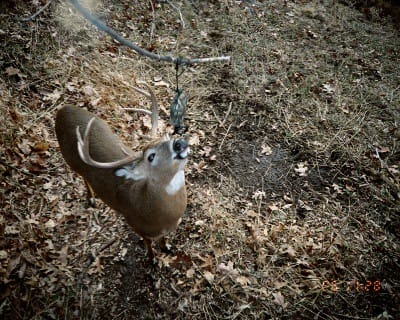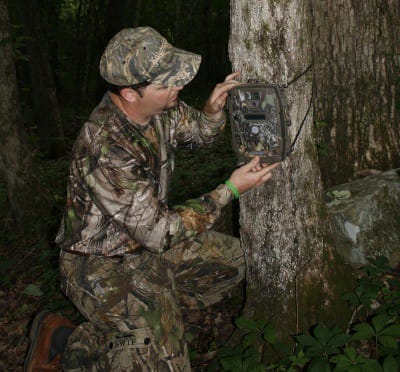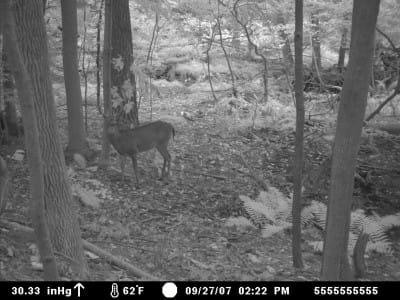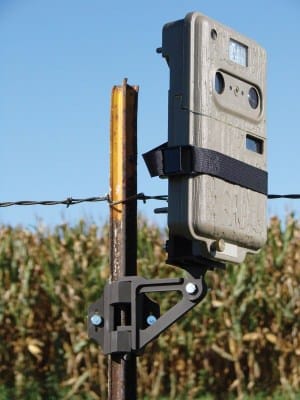
Scouting cameras have changed the way hunters hunt big game animals. Before there were scouting cameras, most of us scouted deer and other big game animals by looking at sign in the woods like runways, scrapes and rubs. For many years, the moment we pulled the trigger on a buck or bull it was the first time we ever laid eyes on the animal. Now many bowhunters use scouting cameras all summer and by the time fall arrives, we have numerous photos of certain bucks on film.
Scouting cameras help hunters locate new hunting areas. My friends and I have found big bucks in places we wouldn’t have hunted 10 years ago. I couldn’t believe my eyes looking at the digital images on a scouting camera that hung in a few-acre chunk of land surrounded by houses. What I saw was a buck that would likely make the Pope & Young record book. Scouting cameras have taught me that big bucks can live anywhere, including the city and the suburbs. Big bucks are like thieves in the night and scouting cameras are often the only way to catch them on the move.

I think many big bucks are taken in deer season because they were first seen on a scouting camera. Let’s face it: when a scouting camera proves there is a big buck in your hunting area, you are more apt to hunt more and stay in the tree longer just to get a glimpse of the buck and hopefully a shot opportunity. Being more persistent and hunting more often increases the odds of harvesting a buck.
I recently harvested a large black bear in Quebec. I hunted seven days and never saw a bear until the last evening of the hunt. I was going to give up on the evening of the sixth day. The only reason I hunted the seventh and final day was because a scouting camera placed over a bait station proved a big bruin was in the area.

Scouting cameras aren’t perfect though. Often the photos come back blurry, very bright or even black which could cause a buck to slip away without being detected. Many of these problems can be fixed by knowing how to setup a camera properly andknowing the difference between a good camera and a bad one before you place your hard-earned cash on the countertop.
When choosing a camera, purchase a digital model that stores the images on a flash card of some type so you don’t have to buy film. You can use Photoshop to zoom in on the photos and touch them up if needed. Photoshop can take a bad photo and turn it decent enough to know what’s in the photo. Second, purchase a camera that has a good photo taking range. Some will take a photo further away than others. If your camera will only take a photo out to 10 feet, you will miss everything else beyond that point. Having a camera with a wide range is a must.
Third, get a camera that has infrared capabilities so it can take pictures at night without flashing, which can spook game. Regardless if you get a camera with infrared or with a regular flash, make sure the flash and the infrared unit is bright. I hate seeing pictures that are only half lit up. A weak flash won’t reach out as far as a strong flash or infrared unit will. Having a camera that has a built-in viewer is nice too. Last but not least is the trigger speed. The faster the camera takes a picture of the deer walking by, the better photo you will get. No one likes photos of the butt of a deer.
One thing that can make or break a good scouting camera photo is the placement of the camera in the woods. If the camera is eight feet off the ground, you won’t get very good photos. If there are lots of branches in the way of the scrape you are trying to get a picture of, you will see lots of photos of a deer with branches in front of it.
I think a major reason why hunters get bad photos is because we don’t always have a good place to hang the camera. Pine Ridge Archery makes a camera support called the AT-5 that can be put on a tree or a fence post. The AT-5 can be tilted up or down so you can get the perfect angled shot. Instead of using a stick or a rock to get the camera in the right place, the AT-5 support does it for you. Since it can be clamped onto a fence post, you can simply put a fence post in the ground where you want to take pictures if you can’t find a suitable tree. Remember to hang your camera at the proper height of the animal you are trying to take pictures of. If you are scouting turkeys, five feet high might be too high. If you are scouting deer, four or five feet might be just right.

If you are worried about getting your camera stolen, Moultrie and other companies make secure boxes that you can lock your camera into to discourage thieves. Nothing will stop someone who wants your camera bad enough but at least with a theft-resistant camera, the lazy thieves will be discouraged. By purchasing a good camera, a clearing brush that will get in the way of your lens and using a support to hold your camera instead of a Charlie Brown tree, you will get better photos and hopefully use more hunting tags as a result.



